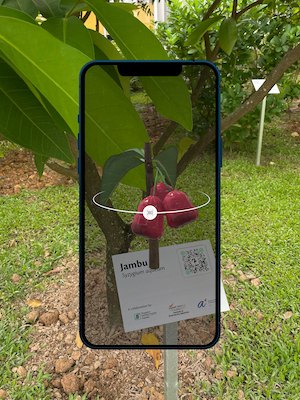
This article is published in collaboration with The MeshMinds Foundation.
The metaverse, with its boundless potential for immersive experiences, has the ability to revolutionize environmental education and action. Through a series of interviews with educators, developers, and youth audiences, I plan to uncover the transformative potential of the metaverse in spurring climate action. I will delve into how virtual environments can simulate the real-world impacts of climate change, fostering a deeper understanding and urgency among audiences, particularly Generation Alpha. Highlighting projects from around the world that encourage real world action and behavioral change, I will explore how these platforms not only educate but also empower users to envision and advocate for sustainable futures.
One such groundbreaking initiative is the Bicentennial Genomic Garden at the Singapore General Hospital (SGH). Developed by HOL, a user experience consultancy that focuses on changing perceptions, converting impressions, and building relationships, the project represents a pioneering step in using immersive digital technologies to explore and communicate the health-promoting properties of plants, contributing significantly to our understanding of biodiversity medicine. The garden is a project of the SingHealth Duke-NUS Institute of Biodiversity Medicine, a joint initiative by the Singapore Health Service and Duke-NUS Medical School.
The genomic garden is not just a physical space but is also the inspiration for a vibrant, interactive platform that educates users about the medicinal benefits of plants through a virtual experience. By deploying gamification, personalization, and socialization strategies, HOL created a way for users to connect with and appreciate the intricate relationship between plants and human health. This project exemplifies how immersive technologies can be deployed to inform and engage the public, particularly in understanding the healing properties of plants and the significance of preserving our planet's biodiversity for future generations.
Angeline Tong, chief experience officer at HOL, shares her insights into the creative process behind the genomic garden, the challenges, and the role of developers in inspiring real-world change.
Can you describe the process and inspiration behind developing the world’s first immersive digital genomic garden on biodiversity medicine at Singapore General Hospital? What challenges did you face, and how did you overcome them?”
One of the challenges we faced while working on the SGH Bicentennial Genomic Garden was: “How do we present academic content in an interesting and relatable manner?” We needed a balance between the content laypersons are willing to engage with, and the rich amount of information the researchers at the SingHealth Duke-NUS Institute of Biodiversity Medicine wanted to share.
Our starting point was to conduct user research and testing in order to group the information into what people would willingly read; information that required little motivation to read; and information that people were not interested in. Once we made the distinction, we shifted our focus to motivating users to engage with the content.
After our user research and testing, we landed on three words—gamification, personalization, and socialization.
Gamification. Most people enjoy some form of games. This can help users become interested in the content in the first instance. Most people lose interest when presented with unfamiliar scientific terms. Our proposal was to gamify the genetic garden experience and make it engaging.
Personalization. Users would be free to explore the space however they liked. They could decide how they wanted to enjoy the experience in the garden.
Socialization. Users would be invited to take photos with our 3D models of the plants and share them on social media.
Greater awareness of the research could motivate users to engage in small actions to contribute to this important initiative—either by spreading the word in the community or by expanding their personal knowledge.
When we design experiences, we always think about how users engage with content. If we provide too much information, users quickly lose interest. But, if the information is scant, we lose an opportunity to share valuable content. In this case, it was important to lower the entry point while keeping the essence of the research.
How do you see immersive technologies like the ones you develop contributing to broader environmental awareness and action?
Immersive technologies can really help to increase environmental awareness and action by putting the problem in focus. It also makes the storytelling bidirectional. Single directional communication via simple information download through videos and news sites only works on users who are already interested.
Interactive and immersive technology changes the way we reach a more passive group of users. It allows users to control what they want to see. We can then start building on that once their interest has been piqued.
When an experience lacks immersive technologies, it contributes to the perception of a space as boring or dated. And this reduces visitor engagement. With the growing interest in immersive technologies, it is necessary to incorporate these technologies in order to transform how people perceive, understand, and engage with environmental issues.
Most people are not apathetic. They care about the environment and want to take action. But, they may not know how to contribute. By providing more information that people can relate to, more people would become emotionally engaged and motivated to take action.

In your view, what role can tech for good developers play in creating virtual experiences that inspire real-world change, particularly in the context of climate action and sustainability?
From our perspective, there are two ways to inspire real-world change. The first would be to create an accurate picture of what is going to happen in the future. We can use mixed reality and immersive spaces to show people what would happen if nothing changes. Some people may see this as a type of fear mongering but it could serve as an effective way to evoke emotions that ultimately spark action.
Another way to inspire change would be to use edutainment, which is about educating people through entertainment. Whether we want an immersive digital gallery, or impactful, capsule activations such as gamification and augmented reality experiences, this approach lowers the barriers of entry for laypersons who find it challenging to enjoy important but relatively heavy content. It can foster unconscious behavioral change and inspire individuals to make a positive impact.
Technology is commonly associated with cold, logical precision but by crafting engaging experiences, we have the potential to reshape mindsets and evoke emotions in visitors.
The SGH Bicentennial Garden is a 3,400-square meter space that has become a unique part of the hospital infrastructure. The garden is an oasis of calm and relaxation for patients, staff and visitors alike, with its explosion of colors and scents from flowering plants and tropical herbs like pandan and lemongrass.
As the garden was only launched in January 2024, it will take some time before we can see its direct impact on environmental action. However, by raising public awareness about the therapeutic potential of local plants, the hope is to inspire a greater love and respect for nature, leading to more conscious consumerism. Another benefit of going digital is that it has eliminated the need to print brochures and worksheets that often create paper waste.
If you are in Singapore, head to Singapore General Hospital at Outram Road and head toward the SGH Museum to experience it.
 Kay Poh Gek Vasey
Kay Poh Gek Vasey
Founder, MeshMinds Foundation; Chief Connecting Officer, MeshMinds
Kay Poh Gek Vasey is the chief connecting officer at MeshMinds, which operates as a creative technology studio. Vasey offers expertise and advocacy on XR creation and production; metaverse pedagogy; digital sustainability; digital transformation; and the future of art and creativity. She believes in the power of artists to inform conversations and inspire positive actions that result in measurable impact for a better world.


